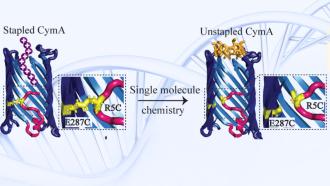
As we grow older, our memory starts walking down the slope. But for some, their memory tumbles down so fast that they forget the most basic things in life--eating, speaking or the names of family members. This condition is broadly known as dementia and Alzheimer’s disease is the most common type of dementia. Today, approximately 1.6 million elders in India live with Alzheimer’s--a disease without a cure. However, detecting the onset of this disease early on can help manage it. Now, a study by researchers at the Indian Institute of Science, Bengaluru, has thrown some insights into detecting the disease early on.
Alzheimer’s disease was first described by Dr. Alois Alzheimer in 1906. Even after a century, scientists are still looking for a cure. Progress in understanding the abnormalities in the brain at a cellular and genetic level offers new hope. “Research across the world has revealed that, in case of Alzheimer’s, changes at a molecular level start at least two decades before observable symptoms”, says Prof. Vijayalakshmi Ravindranath from IISc, who led the study.
In the study, published in the The Journal of Neuroscience, the researchers have, for the first time, shown that the loss of a type of cytoskeletal protein is one of the factors responsible for the cognitive malfunctions observed in Alzheimer’s disease. “In our study, we tried to find how soon the molecular changes occur during the course of Alzheimer’s progression. These changes could be used to develop early diagnostic tests”, remarks Dr. Ravindranath, talking about the importance of the study.
Our nervous system, including the brain, is made up of about 100 billion nerve cells called neurons. Each neuron has a cell body, a long tail-like structure called axon, and branch-like structures called dendrites. Dendrites collect information from the axons of neighbouring neurons. The dendritic spine is a small protrusion from the dendrites and are centers for receiving information. They are operated primarily by actin, a cytoskeletal (cell skeleton) protein.
In the neurons, actin exists in two states--globular actin (G-actin) and filamentous actin (F-actin). F-actin is one of the factors responsible for major activities like maintaining the morphology of the dendritic spine, as well as memory. Many G-actin molecules come together to form F-actin. Studies have shown that higher the F-actin molecules, better is the brain activity. Therefore, maintaining healthy numbers of these two molecules in the neurons plays a key role in the functioning of dendrites. In their study, the researchers found that the loss of F-actin could lead to Alzheimer’s.
The researchers studied the F-actin and G-actin levels in the brain cells of mice and humans suffering from Alzheimer's. They also carried out biochemical and behavioral experiments to investigate the change in the structure and composition of F-actin molecules, and the resulting changes to the dendritic spines since any changes to memory functions are related to these spines. A special type of microscopy helped the scientists to observe the rapid breakdown of F-actin in the neurons.
The results showed that when F-actin was broken down in the brain cells of the mice, the architecture of the dendritic spines was altered. These changes were observed at the tender age of one month, which is unusual since the symptoms of Alzheimer’s are usually seen at seven to nine months. When the researchers used a stabilizing chemical to stop the breakdown of F-actin, a positive outcome was seen. However, when the breakdown of F-actin was accelerated with a destabilizing chemical, the researchers observed behavior changes characteristic of Alzheimer’s.
The researchers also observed reduced F-actin levels in human brains that belonged to Alzheimer’s patients, as compared to normal levels. They concluded that any kind of harm caused to F-actin was observed at a very early stage in the disease process. “Our study demonstrates that loss of F-actin as an early indicator of synaptic dysfunction in Alzheimer’s disease. This could be used as a biomarker for an early detection”, says Dr. Ravindranath, whose team is currently trying to identify the molecular mechanisms that underlie the disassembly of F-actin.
The study could bring hope for many who may have time on their side as early detection of Alzheimer’s could make their life better.“Nothing can last forever. There isn't any memory, no matter how intense, that doesn't fade out at last”, wrote Juan Rulfo, a Mexican writer, in his book Pedro Páramo: a Novel about Mexico. While this may indeed be true, watching our loved ones slowly and painstakingly losing out on everything is not an option, right?






